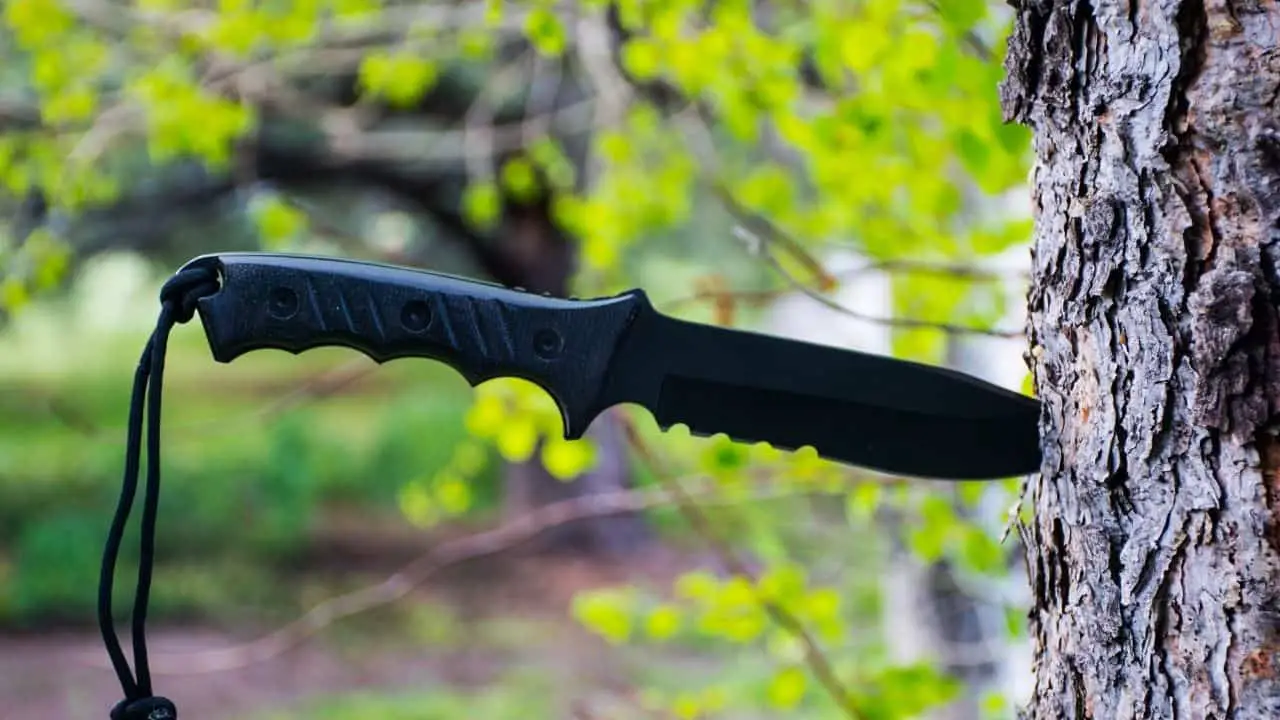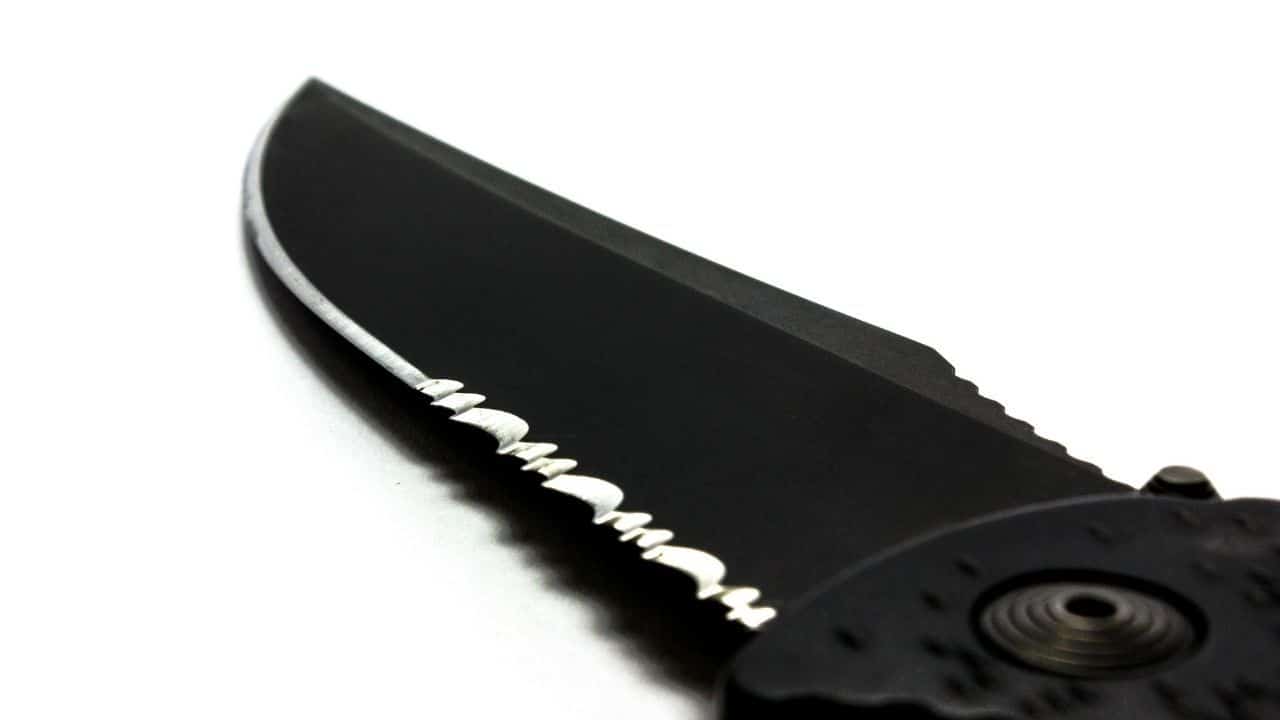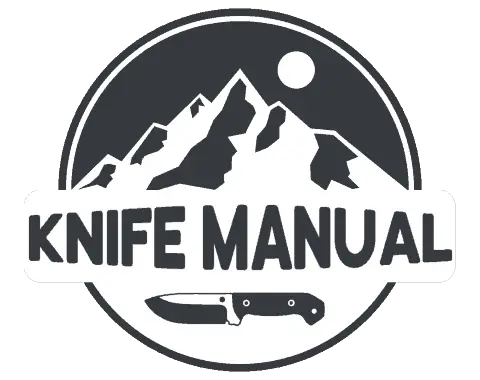
Survival knives are very versatile tools that you often use in many diverse situations. Many people instantly assume that having a serrated blade, or a partially serrated blade, will make their survival knife useful in more cases. However, there is quite a bit more that goes into this, so it is essential to thoroughly scrutinize your options and assess each’s drawbacks and benefits.
Having a survival knife with a serrated blade is not ideal. Sometimes a partially serrated edge can be useful, but serrations that take up more than 1/3 of the blade will often just get in the way. Serrations are also tricky to sharpen, so a plain edge survival knife is usually your best option.
Whether you want a serrated blade or not on a survival knife is a widely debated topic that is primarily up to the individual to decide. However, there are some concrete pros and cons that you can analyze to inform you and help you decide on what is right for you.
In this article, I’ll discuss some of the significant pros and cons of a serrated survival knife, answer whether a partially serrated survival knife is better than a fully serrated one, and how serrations on your blade affect your performance of necessary survival skills. So let’s just get right into it!
Table of Contents
Should a Survival Knife Have a Serrated Blade or Not?
Before we jump into the pros and cons of having a serrated survival knife, it’s first essential to make sure we’re all on the same page when it comes to serrations.
Serrated Knife Blade: Serrated blades , sometimes called sawtooth or toothed blades, are a type of jagged blade edge, much like a stereotypical saw. Depending on the knife, the teeth on a serrated blade can be very fine or quite large. There are also many serration designs, which vary in depth and consistency, but they all do essentially the same job.
, sometimes called sawtooth or toothed blades, are a type of jagged blade edge, much like a stereotypical saw. Depending on the knife, the teeth on a serrated blade can be very fine or quite large. There are also many serration designs, which vary in depth and consistency, but they all do essentially the same job.
Alright, I think I’ve rambled enough! Let’s get into the pros and cons of having a survival knife that has a serrated blade.
Pros of Having a Serrated Blade on a Survival Knife
In reality, the pros of having a serrated blade on a survival knife are pretty few and far between. It is possible to use your imagination and think of outlandish situations where you could use a serrated edge in the outdoors, but you rarely would come across these situations.
For a really great list of tasks that you can complete with a serrated blade, check out my article on the topic .
.
Below are some uses and benefits of having a serrated survival knife:
- Great for sawing through rigid materials
- Excellent for cutting soft or flexible materials
- It stays sharp for a long time and works well even when pretty dull
- It can be used effectively as a self-defense tool
Serrations on a knife blade are great for sawing through various materials using a back-and-forth motion. You can cut rigid and textured materials such as canvas, rope, fabric, leather, and some wood types using a serrated blade. You can also cut softer and more flexible materials using a serrated knife because the teeth can “grip” the material and assist in slicing through it.
Another great thing about a serrated knife is its ability to stay sharp far longer than a plain edge blade. There are exceptions to this if you use your serrated knife a TON or use it for things it isn’t meant to cut, but in most cases, it will stay sharp for quite a long time.
Cons of Having a Serrated Blade on a Survival Knife
One of the biggest cons that comes with a serrated survival knife is its limited number of uses. Plain edge survival knives are efficient tools that you can use for various tasks, while serrated blades are much less versatile and are only really useful in particular instances.
In general, you won’t want your survival knife to have a serrated blade. However, instead of blindly stating this, let’s take a look at some of the reasons why you probably don’t want a serrated survival knife. Below are some of the most common cons that will most likely encounter with a serrated survival knife:
- Not very versatile
- Only useful in very specific situations that aren’t common in survival
- Very difficult to sharpen
- Often get in the way when cutting materials that don’t need serrations
- Will leave jagged cuts and will “chew” up materials
The cons to having a serrated blade as a survival knife just keep stacking up. The more you look into it, the more you realize how impractical and difficult having a serrated survival knife would be in a real-life situation.
Compared to plain edge knives, serrated blades are far less versatile. They are only particularly useful when cutting ropes, fabric, and other materials that you won’t often encounter in a survival situation. Even if you find yourself needing to cut these types of materials, a plain edge knife will work just fine.
Serrations can also be a huge hassle and headache to deal with because they will often get in the way and cause you to work slower at whatever task you are completing. You also will likely find yourself very annoyed when your serrated survival knife “chews” up whatever material you are working with and leaves extremely jagged cuts.
The final and arguably largest problem with serrated survival knives are their ease of resharpening. While it is true that you don’t need to sharpen a serrated blade too often, when you do need to sharpen one, it is a difficult, complex, and lengthy process if you don’t have the correct specialized equipment.
All of these cons that we just discussed, plus plenty more that I didn’t even get around to talking about, suggest that serrated survival knives are far from ideal.
Should a Survival Knife Have a Partially Serrated Blade (Combo Edge)?
So far, we have only gone over fully serrated knives and plain edge ones. When choosing a survival knife, the clear winner between the two is the plain edge knife. However, there is a third option that we have yet to discuss: partially serrated blades.
Partially serrated knives, sometimes called combo edge knives, have the portion of their blade closest to the knife’s handle serrated, while the rest is a plain edge.
serrated, while the rest is a plain edge.
You might be thinking, “partially serrated knives are like the best of both worlds. They give you the versatility of a plain edge knife while also giving you the option to use serrations if the need arises, right?” While you would technically be correct, you will often want to still go with an entirely plain edge knife as a survival blade.

Survival situations where you would be using your survival knife require a ton of physical exertion and lots of knife work. One of the last things you would want to deal with is a knife with a partially serrated blade, which is useful in only a select few instances.
Plain edge knives give you the full length of the blade as a working area and don’t restrict you as much as the back half of your blade had serrations. While definitely better than fully serrated survival knives, partially serrated blades are far less effective and useful in a survival situation than a trust plain edge knife.
Does a Serrated Blade Benefit or Hinder You When Doing Specific Survival Skills?
I’ve gone over many of the pros and cons that come with serrated survival knives, but how do they fare when used to do necessary survival skills? In the next few sections, I’ll take a quick look at some of the most common survival skills and how serrated knives handle each.
Make sure to check out this article if you’re interested in some more interesting and practical ways to use your survival knife in the wilderness.
if you’re interested in some more interesting and practical ways to use your survival knife in the wilderness.
Carving with a Serrated Knife Blade
While it is possible, and you can definitely do it, carving wood with a serrated knife blade is difficult and messy. The teeth on a serrated blade are excellent for sawing through wood, but when it comes to carving, you’ll find much better success if you use a partially serrated (use the plain edge portion of the blade) or plain edge knife.
Hunting and Cleaning Game with a Serrated Knife Blade
Serrations for hunting and cleaning game is a terrible idea. Out of all the possible survival skills that require a knife, skinning an animal requires a sharp, plain edge, thin blade. There is an argument to be made that you can use a serrated knife to cut through bones and difficult tissue, but in most cases, you’ll just rip up the animal and cause more problems with serrations.
Self-Defense with a Serrated Knife Blade
Serrations, much like nearly every sharp object, can be used as a self-defense tool. While plain edge knives tend to stab and slice more easily, serrated blades are more intimidating and could help avoid a self-defense situation in the first place. Serrated knives are not ideal for self-defense but are adequate in most cases and will get the job done.
Shelter Building with a Serrated Knife Blade
Shelter building is one of the few survival skills that could benefit from a serrated knife. A serrated blade’s teeth are perfect for cutting and sawing through wood that you can use to make your shelter. Serrated knives also won’t dull as quickly, so you can cut quite a bit of wood before needing to sharpen your tool.
Serrated knives are terrible for batoning wood, so keep that in mind because it could significantly slow down your shelter building process.
Making Fire with a Serrated Knife Blade
When making fire using primitive methods (such as bowdrill or hand drill), a serrated knife will cause more frustration than it’s worth. Making fire requires precision and the careful cutting of wood, which serrated knives simply can’t provide. Serrated knives are not ideal for making tinder or starting a fire in a survival situation.
If you’re looking to get a really excellent survival knife for your next adventure out in the woods or for your BOB, check out the ones linked below:

